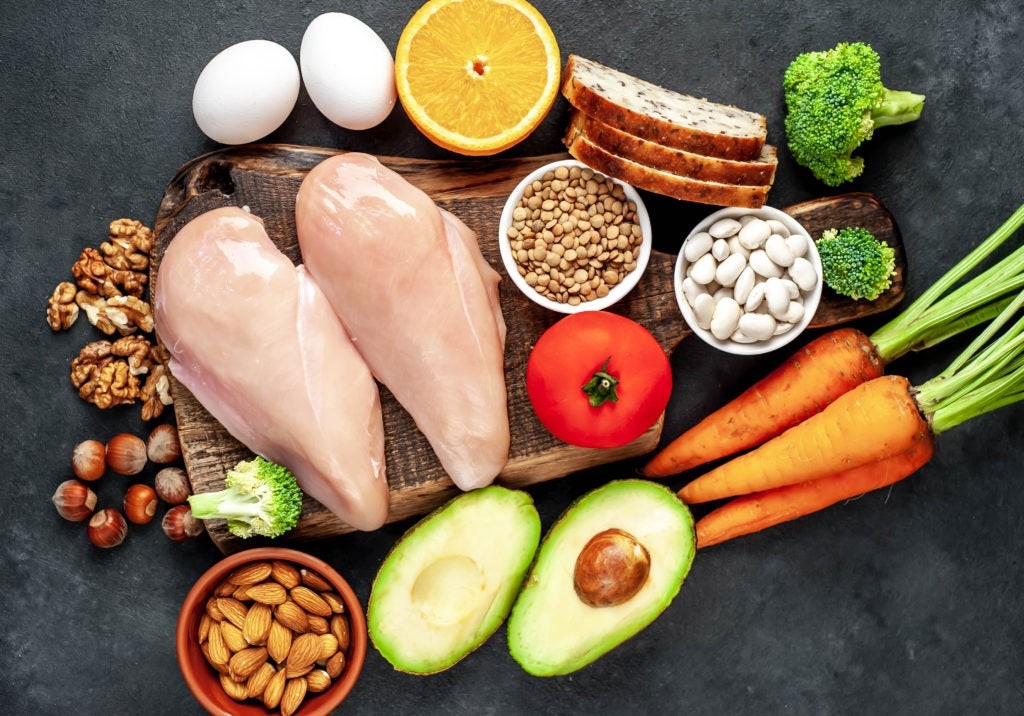Niacin, also known as vitamin B3, is an essential nutrient that plays a crucial role in numerous bodily functions. It’s naturally present in many foods, added to some, and available as a dietary supplement. This guide explores the best food sources of niacin, its health benefits, and potential risks of deficiency or excessive intake.
Understanding Niacin (Vitamin B3)
Niacin exists in two primary forms: nicotinic acid and nicotinamide. The body can also synthesize nicotinamide from tryptophan, an amino acid. Being water-soluble, excess niacin is excreted through urine. This vitamin acts as a coenzyme, vital for over 400 enzymes involved in various reactions, including energy production from nutrients, cholesterol and fat synthesis, DNA creation and repair, and antioxidant activity. [1,2]
 A variety of niacin-rich foods, including legumes, nuts, seeds, carrots, chicken, avocado, eggs, grains, and broccoli, highlighting the diversity of sources for obtaining this essential nutrient.
A variety of niacin-rich foods, including legumes, nuts, seeds, carrots, chicken, avocado, eggs, grains, and broccoli, highlighting the diversity of sources for obtaining this essential nutrient.
Recommended Daily Intake
The Recommended Dietary Allowance (RDA) for niacin is measured in milligrams of Niacin Equivalents (NE). One NE equals 1 mg of niacin or 60 mg of tryptophan.
- Adults (19+ years): 16 mg NE for men, 14 mg NE for women
- Pregnant women: 18 mg NE
- Lactating women: 17 mg NE
The Tolerable Upper Intake Level (UL) for adults is 35 mg daily. Exceeding this amount may lead to adverse health effects.
Health Benefits of Niacin
Cardiovascular Health
Niacin, specifically nicotinic acid, has been used for decades to manage dyslipidemia, a condition characterized by high total and LDL (“bad”) cholesterol, low HDL (“good”) cholesterol, and elevated triglycerides, which are major risk factors for cardiovascular diseases (CVD).
While high doses of nicotinic acid supplements (1,000-2,000 mg daily) can improve cholesterol levels, they often cause side effects like skin flushing and stomach upset, leading to poor patient compliance. Furthermore, recent clinical trials haven’t consistently shown that nicotinic acid reduces cardiovascular events or deaths from CVD. [3,4]
- A 2014 review of 23 randomized controlled trials found that nicotinic acid supplements did not reduce overall deaths, CVD deaths, heart attacks, or strokes, and were associated with negative side effects. [5]
- The FDA has concluded that scientific evidence no longer supports the use of niacin with statins for reducing cardiovascular risk. [6]
Cognitive Health
Severe niacin deficiency is linked to cognitive decline, including memory loss and dementia. Niacin is thought to protect brain cells from stress and injury. However, the impact of smaller variations in dietary niacin intake on brain function is still under investigation.
- A prospective study of 3,718 adults aged 65+ found a protective effect against Alzheimer’s disease and cognitive decline with higher niacin intakes. [7]
- The CARDIA study linked higher niacin intake during young adulthood to better cognitive function scores in midlife. [8]
Ongoing clinical trials are exploring niacin’s potential benefits for brain health. [9]
What Food Is High In Niacin? Top Sources
Niacin deficiency is rare due to its presence in a wide range of foods, both animal and plant-based. Here are some excellent sources:
- Meat: Beef, pork, beef liver (organ meats generally are very high)
- Poultry: Chicken, turkey
- Fish: Tuna, salmon, mackerel
- Grains: Brown rice, fortified cereals and breads
- Nuts and Seeds: Peanuts, sunflower seeds, flax seeds
- Legumes: Beans, lentils, peas
- Vegetables & Fruits: Bananas
Niacin Supplements
Niacin supplements are available as nicotinic acid or nicotinamide. High doses can cause flushing. Prescription niacin is used to treat high cholesterol, often in extended-release form. Due to the high doses required (up to 2,000 mg daily), this should only be used under medical supervision.
Deficiency and Toxicity
Niacin Deficiency
Niacin deficiency is uncommon in developed countries due to its availability in various foods and fortification. Severe deficiency leads to pellagra, characterized by:
- A dark, scaly rash on sun-exposed skin
- Bright red tongue
- Constipation/diarrhea
Other symptoms include depression, headache, fatigue, memory loss, and hallucinations.
Groups at Risk:
- People with limited diets due to poverty or illness
- Populations relying on corn or maize as a primary food source
- Individuals with chronic alcoholism
- Patients with carcinoid syndrome
Niacin Toxicity
Toxicity from food sources is rare, but high-dose supplements can cause:
- Skin flushing, itching, or tingling
- Dizziness
- Low blood pressure
- Fatigue
- Headache
- Upset stomach
- Nausea
- Blurred vision
- Impaired glucose tolerance and liver inflammation (at very high doses)
Key Takeaways
- Niacin (Vitamin B3) is essential for energy metabolism, cholesterol synthesis, and DNA repair.
- Good food sources include meat, poultry, fish, grains, legumes, nuts, and seeds.
- Niacin supplements can improve cholesterol levels but may cause side effects. Use under medical supervision.
- Deficiency is rare in developed countries but can lead to pellagra.
- Toxicity is uncommon from food but possible with high-dose supplements.
Prioritize a balanced diet rich in niacin-rich foods to support overall health. If considering niacin supplements, consult with a healthcare professional.
References
- … (Original references from the source article)
- …
- …
- …
- …
- …
- …
- …
- …
